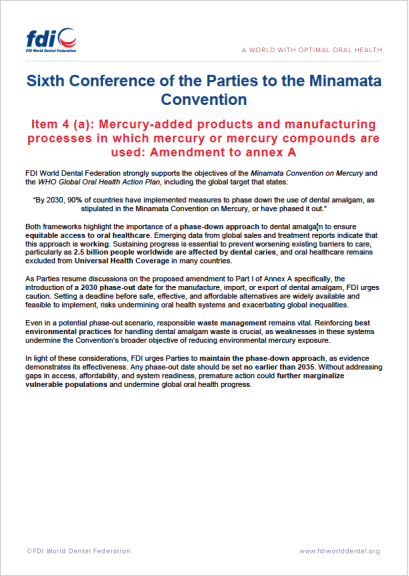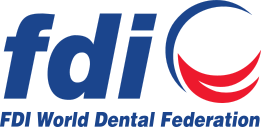
FDI statement on COP6 Item 4(a) - Mercury-added products and manufacturing processes in which mercury or mercury compounds are used
Sixth Conference of the Parties to the Minamata Convention
Item 4 (a): Mercury-added products and manufacturing processes in which mercury or mercury compounds are used: Amendment to annex A
FDI World Dental Federation strongly supports the objectives of the Minamata Convention on Mercury and the WHO Global Oral Health Action Plan, including the global target that states:
“By 2030, 90% of countries have implemented measures to phase down the use of dental amalgam, as stipulated in the Minamata Convention on Mercury, or have phased it out.”
Both frameworks highlight the importance of a phase-down approach to dental amalgam to ensure equitable access to oral healthcare. Emerging data from global sales and treatment reports indicate that this approach is working. Sustaining progress is essential to prevent worsening existing barriers to care, particularly as 2.5 billion people worldwide are affected by dental caries, and oral healthcare remains excluded from Universal Health Coverage in many countries.
As Parties resume discussions on the proposed amendment to Part I of Annex A specifically, the introduction of a 2030 phase-out date for the manufacture, import, or export of dental amalgam, FDI urges caution. Setting a deadline before safe, effective, and affordable alternatives are widely available and feasible to implement, risks undermining oral health systems and exacerbating global inequalities.
Even in a potential phase-out scenario, responsible waste management remains vital. Reinforcing best environmental practices for handling dental amalgam waste is crucial, as weaknesses in these systems undermine the Convention’s broader objective of reducing environmental mercury exposure.
In light of these considerations, FDI urges Parties to maintain the phase-down approach, as evidence demonstrates its effectiveness. Any phase-out date should be set no earlier than 2035. Without addressing gaps in access, affordability, and system readiness, premature action could further marginalize vulnerable populations and undermine global oral health progress.
